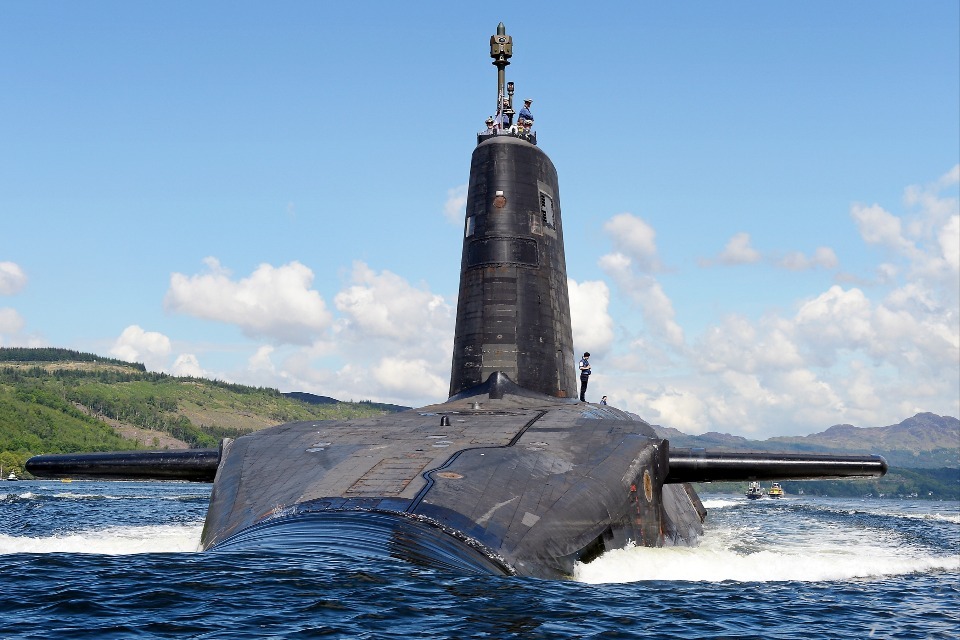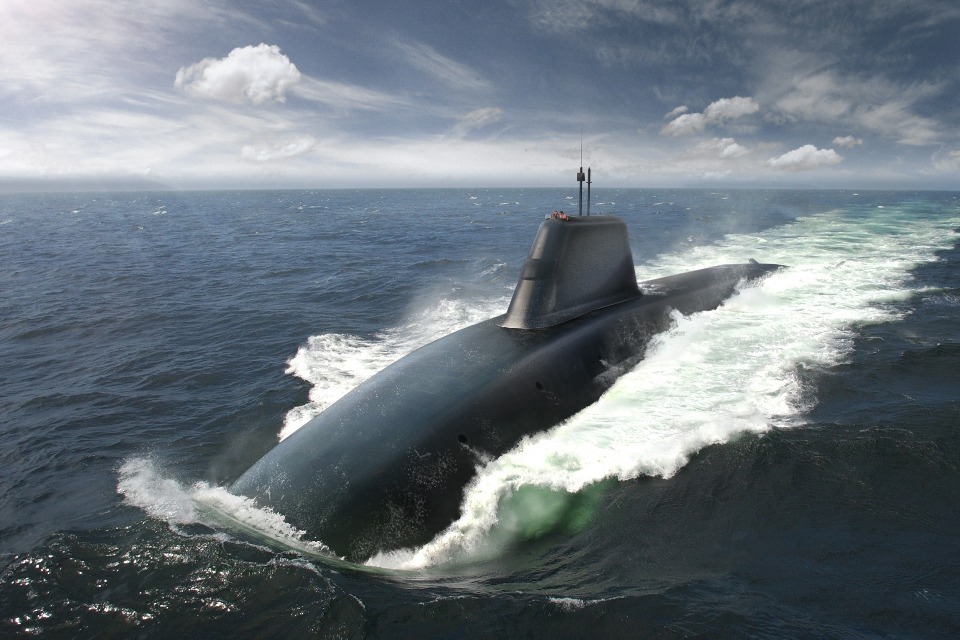Types of UK Royal Navy submarine
Updated 27 October 2025
The SDA is responsible for the procurement, in-service support and disposal of decommissioned UK nuclear submarines. The Royal Navy operates both Attack Submarines (SSN, Submarine, Attack, Nuclear) and Ballistic Missile Submarines (SSBN, Submarine, Ballistic Missile, Nuclear).
1. Attack Submarines (SSNs)
SSNs are conventionally armed, nuclear-powered submarines. The UK’s current SSNs are those of the Astute Class. They protect the UK’s nuclear deterrent from hostile activity and detection, whilst supporting global operations. They also contribute to protecting maritime task groups and providing global strategic intelligence and reconnaissance gathering.
1.1 Astute Class

HMS Ambush returning to His Majesty's Naval Base Clyde on the Clyde estuary under moody skies in Scotland. MOD Crown Copyright.
The Astute Class will consist of seven nuclear-powered submarines. HMS Astute, HMS Ambush, HMS Artful, HMS Audacious and HMS Anson are currently in service. The sixth boat (HMS Agamemnon) and seventh boat (Achilles) remain under construction.
Each Astute Class is 97 metres in length with a displacement of 7,400 tonnes. They are fitted with advanced sonar, carry Spearfish torpedoes and can deliver Tomahawk Land Attack Cruise Missile capability. They are powered by a Pressurised Water Reactor (PWR) that use nuclear fission to convert water into steam to drive the engines and generate electricity.
The Astute Class is at the forefront of underwater warfare, combining the qualities of stealth, endurance, reach, speed, autonomy, flexibility and strike capability. They are the first to utilise high specification video technology to scan the horizon, rather than using a traditional optical periscope. They can also circumnavigate the globe completely submerged and can produce their own oxygen and drinking water.
These characteristics give the Astute Class unparalleled freedom of worldwide operations, including deep under ice, to support UK, NATO and coalition operations.
1.2 SSN-AUKUS

An artist's impression of SSN-AUKUS. MOD Crown Copyright.
SSN-AUKUS submarines are a future class of conventionally armed, nuclear-powered attack submarines being developed in partnership with the US and Australia for the Royal Navy and Royal Australian Navy. The first generation of AUKUS nuclear submarines will be built in the UK and Australia, based on the UK’s world-leading submarine design. The design and manufacturing process will be a complex, multi-decade undertaking.
Construction of the UK’s submarines will take place principally at BAE Systems’ Barrow-in-Furness shipyard. The manufacture of the next generation of nuclear reactors, including reactors for Australia’s SSN-AUKUS submarines, will take place at Rolls-Royce Submarines Ltd site in Raynesway. The UK will supply key components to Australia’s programme, while they develop their domestic industrial capacity. It was announced in March 2024 that BAE Systems will partner with ASC Pty Ltd to build Australia’s nuclear-powered submarines.
The first UK submarines built to this design will be delivered in the late 2030s to replace the current Astute-Class vessels, and the first Australian submarines will follow in the early 2040s.
2. Ballistic Missile Submarines (SSBNs)
SSBNs are nuclear armed and nuclear-powered submarines. The UK’s current SSBNs are those of the Vanguard Class and they maintain the UK’s Continuous at Sea Deterrent. SSBNs guarantee our nuclear deterrent by patrolling the seas at all times, ready to respond to the most extreme threats to the UK.
2.1 Vanguard Class

Royal Navy submarine HMS Victorious departs HMNB Clyde. MOD Crown Copyright.
The Vanguard Class consists of four nuclear-powered ballistic missile submarines – HMS Vanguard, HMS Vengeance, HMS Victorious and HMS Vigilant. Each Vanguard Class is about 150 metres in length with a displacement of 15,900 tonnes. Each submarine is armed with Trident II D5 missiles carrying UK nuclear warheads.
Like the Astute Class, they are powered by a Pressurised Water Reactor. They are fitted with two periscopes which are combined into an optronic mast on the submarine’s fin. With constant power and the ability to produce water and oxygen, Vanguard’s range is only limited by the amount of food onboard.
2.2 Dreadnought Class

An artist's impression of a Dreadnought Class submarine. MOD Crown Copyright.
The Dreadnought Class will consist of four nuclear-powered ballistic missile submarines - Dreadnought, Valiant, Warspite and King George VI. The Dreadnought Class will begin to replace the Vanguard Class from the early 2030s.
Each submarine will be about 150 metres long with a displacement of 15,900 tonnes. They will be equipped with a new generation of Pressurised Water Reactor to provide power and propulsion. The design will incorporate a range of scientifically advanced electronic systems, sensors and tactical weapons, as well as housing the Trident II D5 missile system.
Each Dreadnought Class submarine will accommodate 130 crew members, including three chefs and one doctor. They will also feature separate female crew quarters, toilets and washing facilities.
